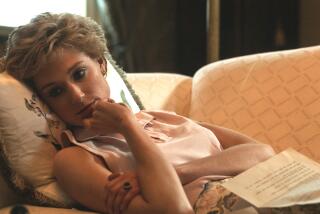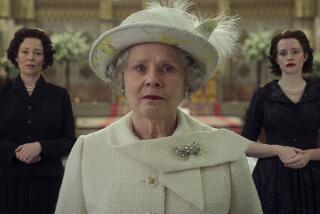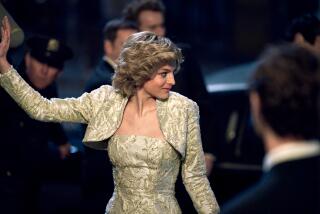Royal Pain : DIANA: The Lonely Princess.<i> By Nicholas Davies (Birch Lane Press: $22.50, 286 pp.)</i> : THE UNRULY QUEEN: The Life of Queen Caroline.<i> By Flora Fraser (Alfred A. Knopf: $35, 560 pp.)</i>
- Share via
Will someone please cut off the Diana book pipeline? If I read one more sickening word about her soon-to-be-former-royal-highness’ colonic irrigations, public relations coups, exercise regimes or palace enemies, I’ll find myself shouting, off with her head! Nicholas Davies, whose last trashy tome was the pointless “Diana: A Princess and Her Troubled Marriage,” has lowered the royal standard even further in “Diana: The Lonely Princess,” a down-and-dirty collection of unattributed gossip, appalling facts and all-too-familiar photos. (Do we really need to see Prince Charles kissing Diana on the balcony yet again?)
“Diana: The Lonely Princess,” which should be subtitled “Whose Fault Is It Anyway?,” opens with a melodramatic account of Diana feeling sorry for herself because she’s alone at Christmas, having turned down the queen’s invitation to join the family at Sandringham. Try not to chortle as the author confides, “Later, Diana would say that she could not remember how many times that day she had gone to the fridge, intent on raiding it, wanting to eat everything she could see for the comfort she knew it would bring her.” She flips through her address book and realizes how few friends she has left. An anonymous former pal explains why: “All Diana would ever talk about was her personal life, her problems, the misery of her marriage.”
Apart from being a narcissistic bore, Diana also appears to be a manipulative loon despite her numerous after-hours sessions with shrink Susie Orbach. (Coming soon, a remake of “What About Bob?” with the princess in the starring role.) According to Davies, Diana told a reporter from the News of the World that she makes impromptu late-night visits to dying patients in several London hospitals, but the hospitals have no record of these visits ever taking place. Upon hearing rumors that Tiggy Legge-Bourke--the fun-loving upper-class nanny that her husband hired to look after their sons--had aborted Charles’ love child, the insanely jealous Diana sidled over to her at a party and said, “So sorry to hear about the baby.” Legge-Bourke burst into tears and instructed her lawyer to demand a retraction of “false allegations.”
Still the item that truly stunned me wasn’t Diana’s insatiable sexual appetite for married men (though I’ll make sure she never meets my husband) or her delightful habit of hurling vases at Charles (once she got him on the back of his head, he collapsed and she feared she’d killed him), or even her complete surprise when the queen demanded that the couple divorce. It was the news that the princess’ brain trust includes infomercial guru Tony Robbins. I pictured her in Kensington Palace, doing a positive thinking exercise on his motivational tape: “Let’s see . . . I obsessively call married men 20 times a day and hang up. What’s great about this problem?”
If you turn on the television in the middle of the night and see Diana pitching hair mousse, don’t be surprised.
Ironically, Charles and Di seem like Romeo and Juliet compared to the royal couple portrayed in Flora Fraser’s staggeringly well-researched “Caroline, the Unruly Queen.” In 1795, Caroline of Brunswick, a German princess, arrived in England to marry her first cousin George, prince of Wales. He was madly in love with another woman, Maria Fitzherbert, and in fact had married her in a religious ceremony, though their union wasn’t recognized by English law. Upon meeting Caroline, who was said to be none too fastidious about personal hygiene, Prince George uttered barely a word, then turned to a servant and asked for a glass of brandy. Still, needing money from Parliament to settle his bills, he wed her, only to cast her aside after several weeks of marriage.
Fraser documents in chilling detail how for the next 26 years George abused his power--first as prince of Wales, then as regent, then as king--to torment his rejected wife. Though Caroline is too reckless and hedonistic to be a sympathetic character, it’s painful to read of her unrelenting humiliation. She was forbidden to live in the same house with their only child, Princess Charlotte, and years later, when Charlotte died tragically after childbirth, Caroline wasn’t informed. While Prince George lived openly with one mistress after another, his spies kept Caroline under constant surveillance and eventually brought her to trial for adultery in the House of Lords.
Not the sort to suffer in silence, Caroline, a muse of Lord Byron and Sir Walter Scott, cavorted with a variety of unsuitable but attractive young officers. In a time when well-bred women rarely traveled, she roamed the world searching for stimulation and admiration and surreptitiously published her correspondence in order to gain public sympathy.
Fraser, the daughter of Lady Antonia Fraser (biographer of Mary Queen of Scots and Oliver Cromwell) and the granddaughter of Elizabeth, Countess of Longford (authorized biographer of Elizabeth II), was given complete access to the royal archives, and thus the reader is treated to wonderful period cartoons of the continuing scandal and intriguing first-hand accounts. For example, Caroline’s report of her wedding night: “Judge what it was to have a drunken husband on one’s wedding day and one who passed the greatest part of his bridal night under the grate, where he fell, and where I left him.”
While the author’s account of the machinations behind Queen Caroline’s trial are particularly vivid, the book isn’t easy reading. It might have been helpful if the author had offered more historical perspective (for instance, she states that in 1798 Princess Charlotte was inoculated for smallpox, yet she fails to mention that Edward Jenner only discovered the vaccine in 1796 and didn’t publish his famous paper until 1801). Still, history buffs will be mesmerized by her account of a dysfunctional marriage that culminated in Caroline’s being barred from her husband’s coronation at Westminster Abbey.
It’s amazing what little difference 200 years makes in the British royal family.
More to Read
Sign up for our Book Club newsletter
Get the latest news, events and more from the Los Angeles Times Book Club, and help us get L.A. reading and talking.
You may occasionally receive promotional content from the Los Angeles Times.








